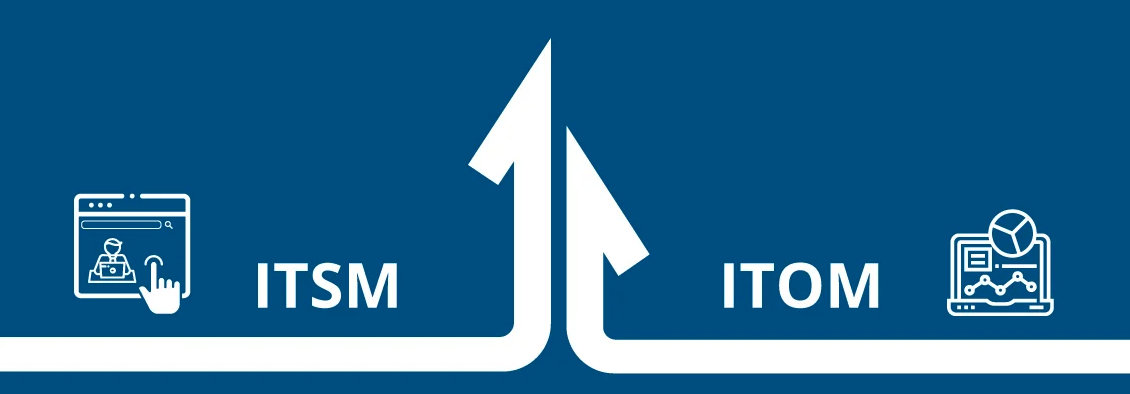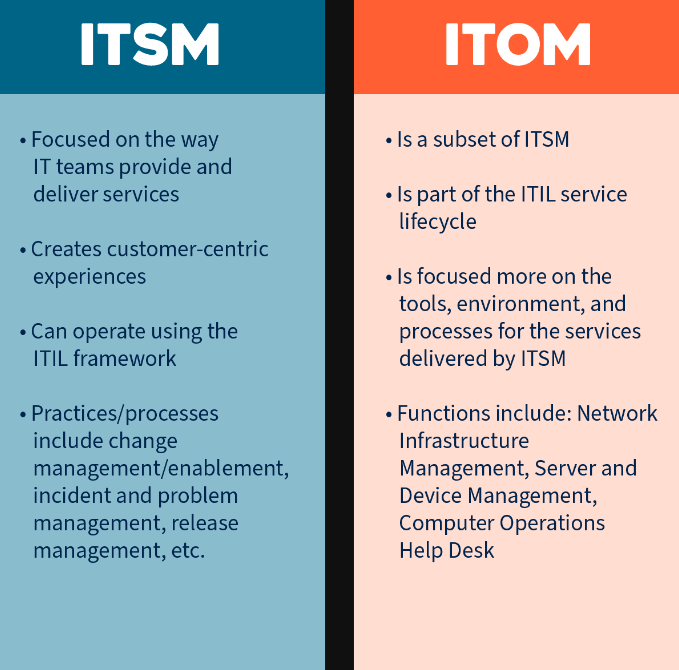
ITOM vs ITSM (Image by opsramp)

ITOM vs ITSM (Image by opsramp)
In the landscape of IT management, there is often a debate about ITOM vs ITSM. IT Operations Management (ITOM) and IT Service Management (ITSM) play pivotal roles, each with distinct yet complementary functions.
In 2023, ITOM trends like observability, AIOps, and cloud migration are in the spotlight, reflecting the increasing complexity of IT environments and the need for advanced operational solutions.
ITSM, on the other hand, is more concerned with delivering and managing IT services to end-users. It encompasses a broader range of processes and practices that aim to align IT services with business needs, focusing on service desk operations, incident and problem management, and change management.
Moreover, the evolving ITSM trends, like the focus on value, people, and enterprise service management, underscore the shift towards a more strategic and people-centric approach in IT service delivery.
This article will discuss ITOM and ITSM so your business can make a transition to improve the experience of your customers and employees through more agile, automated, and smart IT operations management.
As mentioned above, ITOM and ITSM are two distinct yet interrelated domains. They work together to ensure IT services’ smooth functioning and strategic alignment with business goals.
IT Operations Management (ITOM) is the essential framework ensuring the day-to-day smooth operation of an organisation’s IT infrastructure.
ITOM is the backbone of IT, focusing intently on the operational components. This includes maintaining and optimising all elements of IT infrastructure, from ensuring servers are always up and running to managing networks and data storage.
ITOM’s primary goal is to bolster efficiency and reliability in IT operations, ensuring that all systems and services function at their best.
This is achieved through diligent monitoring, smart automation, and a proactive approach to ensuring the continuous availability of IT services.
On the other hand, IT Service Management (ITSM) is a set of practices that governs the design, delivery, operation, and continual enhancement of IT services, aligning them with the needs of businesses and their customers.
ITSM is fundamentally about delivering value. The discipline directly interacts with users, addressing their issues at the service desk, managing IT changes, and ensuring effective service delivery.
ITSM is not just about fixing problems; it’s about providing a seamless IT service experience that meets and exceeds business and customer expectations.
This approach involves various activities aimed at improving service delivery and user satisfaction.
ITSM is the face of IT to its users, prioritising their needs and ensuring that the IT services provided are functional, beneficial, and in sync with overall business objectives.
Please remember at all times ITOM and ITSM are not competitors; they’re teammates. ITOM establishes a solid foundation, while ITSM ensures a seamless user experience.
This differentiation provides a way to better understand and leverage each area for optimal IT service delivery and infrastructure management.
The primary focus of ITOM is squarely on the underlying IT infrastructure and operations. This discipline enhances IT services’ efficiency, availability, and performance.
ITOM professionals are tasked with ensuring that the technological backbone of an organisation – the servers, networks, and data storage systems – are always running smoothly.
By leveraging tools for monitoring, automation, and optimization, ITOM aims to prevent downtime and system failures, ensuring that the business’s digital machinery operates without a hitch. It’s a role that demands a keen eye for detail and a proactive approach to managing IT infrastructure.
In contrast, IT Service Management (ITSM) adopts a more service-oriented approach, focusing on the end-user experience and the quality of IT services delivered.
While ITOM is all about the nuts and bolts of the IT infrastructure, ITSM is concerned with how end users perceive and use these services.
It’s about ensuring that IT services are available effectively, efficiently, and aligned with the business’s and its customers’ needs.
ITSM professionals work on the front lines, directly interacting with users, managing service requests, and resolving incidents, all to deliver a superior IT service experience.
The processes and practices of ITOM and ITSM are distinct yet complementary. ITOM processes like monitoring, automation, capacity planning, and performance management are essential.
These activities are crucial for maintaining the health and efficiency of the IT infrastructure. On the other side, ITSM processes include incident management, problem management, change management, and service request management.
These processes are designed to efficiently handle and resolve user issues, manage changes in the IT environment without causing disruptions, and continually improve the delivery of IT services. Together, these processes ensure the infrastructure and services are managed effectively.

While IT Operations Management (ITOM) and IT Service Management (ITSM) have their unique focuses, they share key similarities that are fundamental to the success of IT services in any organisation.
ITOM and ITSM are united in their overarching goal: to ensure the excellence of IT services. This shared objective forms the cornerstone of their collaboration.
ITOM ensures the infrastructure is robust, reliable, and ready to support the services, while ITSM ensures that these services are delivered effectively to meet user and business needs.
Their success is interdependent – effective IT operations enable smooth service delivery, and quality service management informs and improves IT operations.
This symbiosis is crucial, ensuring that IT works well internally and delivers value and satisfaction externally.
The collaboration between ITOM and ITSM is essential for the overall success and resilience of an organisation’s IT landscape.
Integrating ITOM and ITSM is key to achieving a comprehensive and cohesive IT management strategy. This integration enhances overall visibility across the IT landscape, allowing for more informed decision-making and better alignment with business objectives.
A unified approach enables seamless coordination between managing the IT infrastructure and delivering IT services, improving efficiency and effectiveness.
It also enhances user satisfaction, as issues can be anticipated and resolved more swiftly, and services are more reliably delivered.
By breaking down silos and encouraging collaboration, this integrated approach ensures that the IT organisation is greater than the sum of its parts, capable of delivering high-quality, efficient, and user-centric IT services.
As we wrap up our conversation on ITOM vs ITSM, we know both play pivotal roles in the IT landscape, especially as we move into 2024.
ITOM, with its focus on the operational health of IT infrastructure, is the unseen yet crucial force that keeps the digital wheels of a business turning.
Meanwhile, ITSM, focusing on delivering and managing IT services, is akin to the crew interacting directly with the passengers, ensuring their journey is smooth and their needs are met.
Now, why should you care about this in 2024? The current business world is evolving rapidly, with new technologies emerging and customer expectations soaring.
Cybersecurity threats are more sophisticated, cloud computing is more prevalent, and remote work is now a staple.
In this landscape, having a robust ITOM strategy ensures your IT infrastructure is functional, resilient, and adaptable to these changes.
Meanwhile, a robust ITSM approach guarantees that your IT services are reliable, user-friendly, and aligned with evolving business goals.
Together, ITOM and ITSM provide a comprehensive strategy to face the challenges of 2024. They ensure your IT infrastructure is a support function and a driving force in achieving business agility, resilience, and customer satisfaction.
As someone navigating the complex world of IT, understanding and leveraging ITOM and ITSM can give you a competitive edge, making your business survive and thrive in the ever-changing digital landscape.